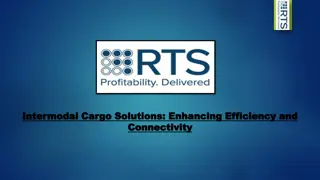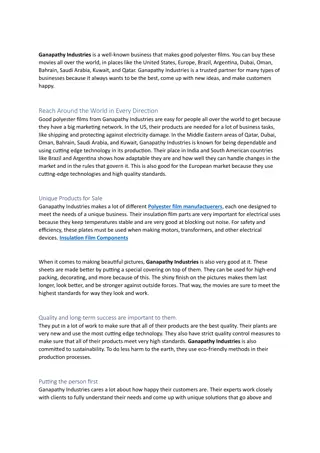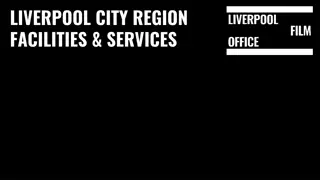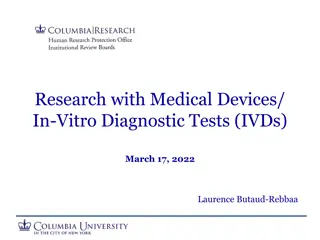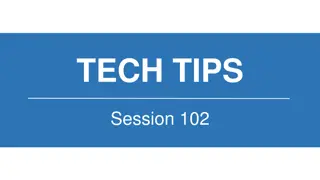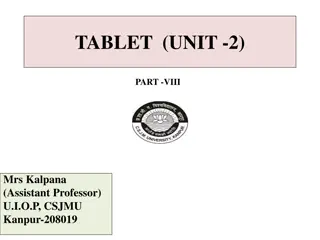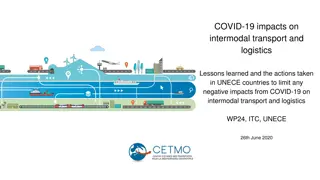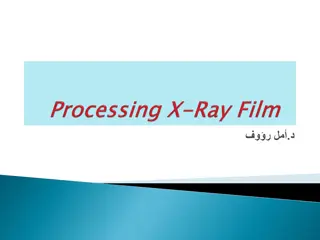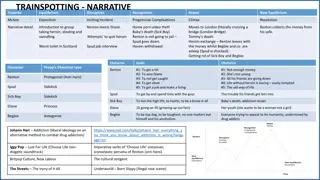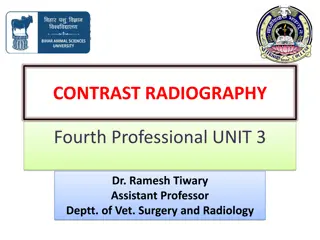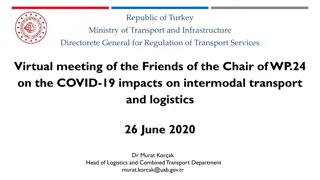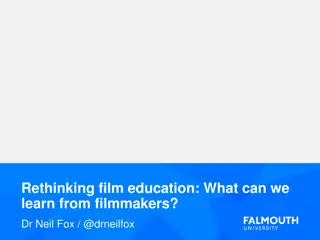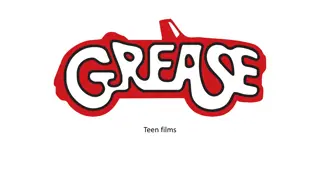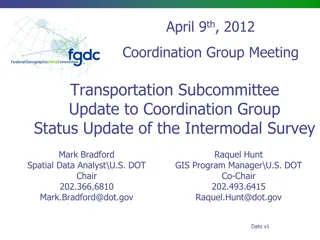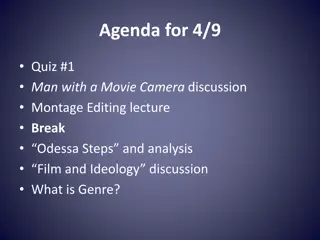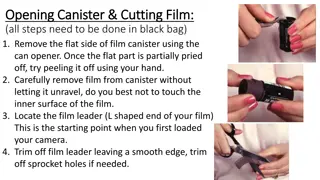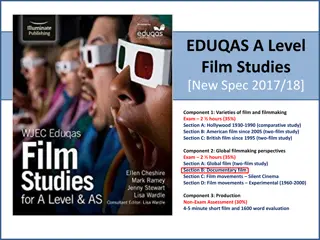Intermodal Contrast: A Narrative Device in Film
Exploring the use of intermodal contrast as a narrative device in films, this study delves into the integration of semiotic modes to create meaning. Various examples from films like Gattaca are analyzed to showcase how different modes interact to convey nuanced messages and enhance storytelling. By examining intermodal interactions and contrast, this research sheds light on the significance of holistic meaning in multimodal texts.
Download Presentation

Please find below an Image/Link to download the presentation.
The content on the website is provided AS IS for your information and personal use only. It may not be sold, licensed, or shared on other websites without obtaining consent from the author. Download presentation by click this link. If you encounter any issues during the download, it is possible that the publisher has removed the file from their server.
E N D
Presentation Transcript
Changing the (Semantic) Frame Intermodal Contrast as a Narrative Device in Film Martin Siefkes Chemnitz University of Technology
Overview 1. Intermodal interaction types (IITs) 2. The IIT Intermodal contrast 3. Multimodality and semantic frames 4. Three filmic examples
What are intermodal interactions? In multimodal texts, semiotic modes are closely integrated how to describe this? Academic disciplines traditionally look at separate modes (e.g. language, music, images, gesture) Multimodality research often focuses on the holistic picture Intermodality / cross-modality: additional textual properties that are caused by relations between modes Intermodal interaction types (IITs): one mode influences the other in a definable way Martin Siefkes (in print), How semiotic modes work together in multimodal texts: Representing intermodal interactions . 10plus1 Living Linguistics 1/2015.
Layers in multimodal texts Text with modes M1, , Mn [Layer] Mode-specific structure for M1, , Mn All interactions I (Mi, , Mj) Holistic meaning for i, j n;i j
Example 1 Gattaca (1997, dir. Andrew Niccols) 13:06 14:28 Gattaca describes a future not too distant from 1997 in which eugenics, and discrimination based on gene tests, are widespread Refers to highly charged discourses of the time
Intermodal contrast Anton and Vincent are playing the game of chicken , by swimming out to sea [Mode1] Narrator s commentary: By the time we were playing at blood brothers, I understood there was something very different flowing through my veins, and I d need an awful lot more than a drop if I was going to get anywhere [Mode2] Moving images: Anton doesn t scratch himself with the sharp shell offered by Vincent Two interpretations are possible: a) Anton doesn t want to be Vincent s blood brother b) Anton is the chicken (= coward), he doesn t dare to scratch himself
Intermodal contrast Could be interpreted as the IIT Intermodal disambiguation Narrator s commentary explains Anton s behavior However: later in the film, Anton is the chicken , he loses the game twice in decisive situations! Intermodal contrast has a double function: 1. explains us Vincent s understanding at the time (intradiegetic information) 2. Narrative hint (extradiegetic information) that Vincent is more courageous Facial expression (as a further mode) supports this ( fearful expression ) haemophobia (fear of blood)
Example 2 Strange Days (1995, dir. Kathryn Bigelow) 6:35 7:26 Another dystopian science fiction film Story about the risks of virtual-reality-recordings of violence and sex used as drugs ( Wire tripping )
Intermodal contrast [Mode1] Moving images: Lenny Nero is travelling in his car through Los Angeles, during Christmas holidays before New Year s eve of the year 2000. Among other scenes of street violence, we see how a man dressed as Santa Claus is chased and assailed. [Mode2] Music: Amen aus Stabat Mater by Giovanni Pergolesi (piece 12: Quando Corpus Amen)
Intermodal contrast Straightforward relation of contrast: Music one the radio is Christian and fits the Christmas mood Street violence in the moving images is in stark contrast Thematic relationship produces intermodal contrast: Christian music images of the hunted Santa Could also be interpreted as Intermodal irony The music expresses the traditional image of Christmas Images are an ironic commentary on the Christmas message Amen translates as so be it : Music as ironic commentary on images
What are semantic frames? Background knowledge in texts Two traditions: Artificial intelligence research and Frame semantics (Minsky 1975, Schank/Abelson 1977). Linguistics: development of case grammar (Charles J. Fillmore; Ziem 2012) Verb arguments have semantic roles (e.g. Agent, Object, Goal, Location, etc.) Computer linguistics: Knowledge representation: ontologies; FrameNet; Semantic Web (OWL)
Semantic frames in film All semiotic artefacts are structured by frames Frames can be used to describe background knowledge in a general format Intermodal relations can be established through frames
Social / cultural change and textual depictions Frames describe the conceptualisation of a domain of a society Changing understanding of cultural domains can be understood as frame change Frame theory can be applied in film analysis: e.g. by comparing films from different times or cultures In Gattaca, changing conceptualisations are part of the subject matter of the film
Example 3 Gattaca (1997, dir. Andrew Niccols) 9:00 10:35
Intermodal differences between semantic frames Music & images of the conception scene refer to the frame Conception & Birth (1997)real Verbal language [narrative commentary] refers to the frame Conception & Birth (not-too-distant future)real Intermodal irony or Intermodal commentary additional textual properties! Gattaca, 10:35 10:58: images give examples for what is more generally described in the verbal commentary. Exemplification
Frame Conception & Birth (1997)real Actors: mother, father, child, doctor, Events: love-making, conception, pregnancy, birth, health checks for the baby, Script: <love-making conception pregnancy birth health checks> Locations: private home, hospital, Artefacts: hospital bed, Terms & idioms: intelligence quotient , A child conceived in love has a greater chance of happiness ,
Frame Conception & Birth (future that is not too distant from 1997)fictional Actors: mother, father, child, geneticist, doctor, Events: in-vitro fertilisation, testing of embryos, selection of suitable embryo (in consultation with the parents), conception, pregnancy, birth, genetic test, Locations: private home, geneticist s practice, hospital, Artefacts: hospital bed, automated blood tests, genetic test set, Terms & idioms: God s child , faith birth , genetic quotient , borrowed ladder , genoism , Social norms: Discrimination is forbidden by law, but common ( No one takes the law seriously )
Frame networks Frames are connected: e.g. the frame Conception & Birth would be linked through the frame element Caesarean section with the frame Operation (hyperonym) Links are possible via elements (e.g. actors, events ) Connected frames (1997): connected frames are Love, Emotion, Family, Religion, Life, Connected frames (a future not too distant from 1997): Genetic Engineering (contains methods of Birth & Conception) Science (contains the social domain structuring the frame) Eugenics (describing cultural practices and goals of the frame)
Framing in film Films (and other texts) make use of frames to draw on existing cultural understanding Thorough world construction includes fictional conceptualisation, terminology, social norms & practices Frame templates have to be expanded accordingly Frame change changes in world knowledge Use of frames to describe fictional worlds is genre specific: frequently used in science fiction & fantasy
Conclusion Proposal: differentiating types of intermodal interactions (IITs) The examples show that IITs influence textual meaning and have narrative functions Sometimes different IITs can be assumed (depending on analysis) IITs are connected with mode specialisation They are an additional layer of textual meaning that has to be considered in any theory of multimodality!
Selected bibliography on multimodality, intermodal interactions, and frames BATEMAN, JOHN (2011), The decomposability of semiotic modes , in: O Halloran, Kay & Bradley Smith (eds.) (2011), Multimodal Studies. Exploring Issues and Domains. London: Routledge, 17-38. BATEMAN, JOHN (2014), Text and Image. A Critical Introduction to the Visual-Verbal Divide. New York: Routledge. BATEMAN, JOHN & SCHMIDT, KARL-HEINRICH (2011), Multimodal Film Analysis. How Films Mean. London: Routledge. CALVERT, GEMMA, SPENCE, CHARLES & STEIN, BARRY (2004), The Handbook of Multisensory Processes. Cambridge MA: MIT. ELLESTR M, LARS (ed.) (2011), Media Borders, Multimodality and Intermediality. London: Palgrave Macmillan. FILLMORE, CHARLES (1982), Frame semantics , in: Linguistics in the Morning Calm. Papers presented at the Seoul International Conference on Linguistics. Seoul: Hanshin, 111-137. FRICKE, ELLEN(2006), Intermedialit t, Stil und Mental Spaces: Das Visuelle als Dimension musikalischen Komponierens in Georg Nussbaumers Installationsoper orpheusarchipel . Kodikas/Code 29(1-3), 137-155. FRICKE, ELLEN (2013), Towards a unified grammar of gesture and speech: A multimodal approach , in: Cornelia M ller et al. (eds.), Body Language Communication. An International Handbook on Multimodality in Human Interaction. Berlin: de Gruyter, vol. 1, 733 754. LIU, YU & O HALLORAN, KAY (2009), Intersemiotic texture: Analyzing cohesive devices between language and images . Social Semiotics 19(4), 367-388. MARSH, EMILY E. & WHITE, MARILYN D. (2003), A taxonomy of relationships between images and text , Journal of Documentation 59(6), 647 672. MARTINEC, RADAN & SALWAY, ANDREW (2005), A system for image-text relations in new (and old) media , Visual Communication 4(3), 339 374. MINSKY, MARVIN (1975), A Framework for Representing Knowledge , in: Patrick H. Winston (ed.), The Psychology of Computer Vision. New York: McGraw-Hill. OVIATT, SHARON L. (1999), Ten myths of multimodal interaction . Communications of the ACM 42,11: 74-81. SCHANK, ROGER C. & ABELSON, ROBERT P. (1977), Scripts, Plans, Goals, and Understanding. An Inquiry into Human Knowledge Structures. Hillsdale, NJ: Erlbaum. SIEFKES, MARTIN (in print), An Experimental Approach to Multimodality. Investigating the Interactions between Musical and Architectural Styles in Aesthetic Perception , in: Building Bridges for Multimodal Research. Theories and Practices of Multimodal Analysis. Bern/New York: Peter Lang. SIEFKES, MARTIN (in review), Frames in discourse. Connecting frame semantics and discourse analysis in an SDRT-based model . WENGELER, MARTIN (2003), Topos und Diskurs. Begr ndung einer argumentationsanalytischen Methode und ihre Anwendung auf den Migrationsdiskurs (1960 1985). T bingen: Niemeyer. WILDFEUER, JANINA (2012), Intersemiosis in Film: Towards a New Organisation of Semiotic Resources in Multimodal Filmic Text . Multimodal Communication 1, 3: 276-304.







